A week spent with the smallest member of the Prius Family
Pros:
Fuel economy
Around town handling
Versatility
Cons:
Plain interior
Cheap looking carpeting
Brake pedal modulation
Toyota Prius lineup
Through the first nine months of 2012, the Prius was the best-selling carline in California. Seizing and holding onto that crown can largely be seen as a result of Toyota's decision to expand the Prius lineup from its midsize hatchback roots to include both the Prius v station wagon as well as the model we're looking at today, the compact Prius c hatchback.

2012 Toyota Prius c
Unveiled in concept form at the 2011 North American International Auto Show in Detroit alongside the production Prius v and in production form in North America at the 2012 Detroit show, the Prius c (the "c" standing for "city") represents the first Prius model based on Toyota's Yaris platform. It's also the smallest member of what has become the Prius family of vehicles.
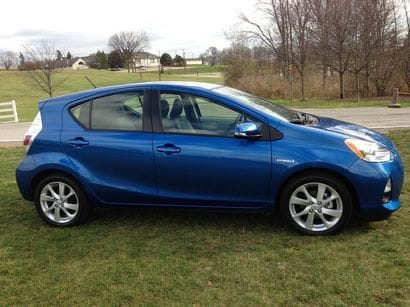
Exterior
While this smallest of Prii may be based on the same platform as the Yaris, it shares not a single body panel with the other Toyota compact. Largely due to its size, it also breaks from other members of the Prius family, as well.

While there is a nod to some basic Prius styling cues - the headlamp enclosures are more stylized than the Yaris and include a vestigial airfoil on top, the lower fascia features side scoops that flank narrow upper and lower air intakes and the taillights feature the same vertical motif as the Prius and Prius v – the rest of the design is, thankfully, more conventional than either of the other two Prius body styles. In this case, conventionality is a good thing and, because of it, the Prius c is more stylish and less nerdy-looking than its brethren.
Beginning with the fairly aggressive front end and steeply raked windshield, the roofline of the Prius c flows back to a fairly large upper rear spoiler. In back,the rear hatch, beginning at the center, bows in slightly towards the bottom and even more so towards the top. All this is bracketed by a pair of large, vertical transparent taillamp housings, giving the c a very sporty appearance.
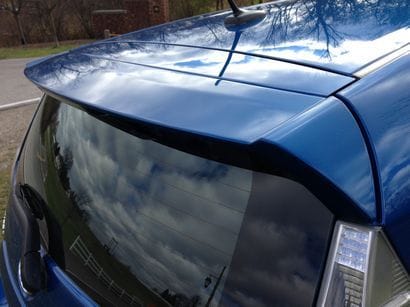
Along the sides, an upper character line, beginning behind the front wheel wells, bisects both front and rear door handles and ends at the rear taillamp housing. At the same time, a more pronounced lower character line rises from just behind the front wheel well, ending in a pronounced quarter panel flare around the rear wheel wells.
The Prius c sits on a 100.4 inch wheelbase (up nearly 1.5 inches from the Yaris), is 157.3 inches long (up 1.5 inches from the Yaris), with both a wider front and rear track than its gasoline-only sibling. It's also 2.5 inches lower.
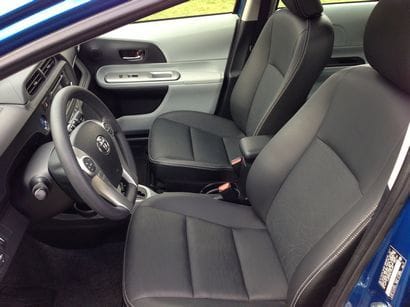
Interior
Inside it's mostly hard plastic surfaces, but multiple textures and a two-tone trim scheme dress up what would otherwise be a pretty mundane cabin. Instrumentation is clear and straightforward while the seats, although they look flat and uncomfortable, are surprisingly supportive.
Front seat passengers will also find generous amounts of head and legroom with the seats, like the rear bench, covered in a rich looking and feeling "SofTex" material. Both the driver and front passenger seats are heated and feature manual adjustments (six for the driver, four for the passenger).

The steering wheel both tilts and telescopes and contains controls for the audio system, Bluetooth phone and voice command buttons, temperature controls and trip and information center display features. It's also flat on the bottom, allowing for more driver leg room.
The center stack contains a 6.1 inch touch screen along with redundant controls for the infotainment system, while the pod below this display contains the controls for the automatic climate control system. Unlike the Prius v, I had no issues with either the size or the location of any of the touchscreen buttons. Another plus: the Prius c eschews the unintuitive transmission dashboard joystick – hurrah - for a more conventional lever located in the center console.

It should also be noted that I was able to pair my iPhone to the Prius c's Bluetooth system in under a minute without even having to consult the owner's manual –my own litmus test for user friendliness.
Rear seat passengers will find plenty of headroom and legroom, while the rear doors are large enough to allow easy ingress and egress for passengers.
Speaking of space, overall interior volume is 104 cubic feet, with 87.4 cubic feet of passenger volume and 17.1 cubic feet of cargo volume behind the rear seat, while a rear cargo cover is standard.

Due to the relatively low beltline and cowl as well as a generous glass area, the view out the front, back and sides is excellent.
One particularly cool feature, available on both the Prius c Three and Prius c Four, is the proximity Smart Key System that allows you to lock and unlock the front doors and rear hatch, as well as start the car, as long as you have the key fob with you.
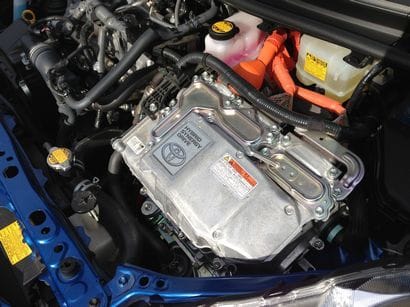
C is for city
All Prius cs come with the same engine/motor/transmission configuration: a 1.5-liter four-cylinder, Atkinson cycle engine with independent variable valve timing along with a 60 horsepower electric motor within a Continuously Variable Transaxle that, combined, generate a total of 99 horsepower.
On the road, the Prius c exhibits a well-controlled ride. Because it's a small car with a relatively large footprint, it also exhibits the least amount of body lean of any Prius. The end result is (ta-dah!) that it can be a lot of fun zipping along city streets and, dare I say, being thrown into corners.

I'm not intimating that the Prius c is in the same league as, say the Mazda2 – far from it. But it is, in its own way, highly entertaining – especially when compared with either the Prius or the Prius v.
Freeway driving, on the other hand, is not nearly as much fun. Merging onto traffic or passing on hills, especially at highway speeds, requires a bit of forethought as it's easy for most vehicles to out-accelerate this small Prius. In addition, any time you have a tendency to put your foot into it, coarse sounds emerge from beneath the hood and the engine sounds as if its straining.
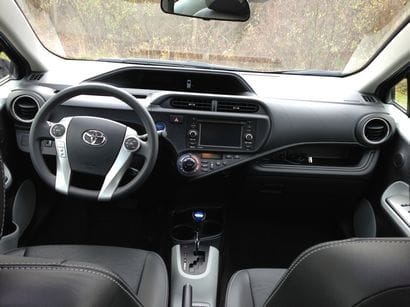
That being said, I should also note that, given its dimensions, the ride is surprising controlled although road and wind noise can be somewhat intrusive – although not any more than most compact hatchbacks.
Another thing that requires a bit of finesse is the c's brakes. While the brakes work extremely well, the pedal can be difficult to modulate. At times, pressing down on the brake pedal in a linear fashion begins with a gradual slowing and moves to all-out braking with nothing in between.

Equipment
Rather than rely on option packages, Toyota offers the Prius c in four trim levels – the Prius c One, Prius c Two, Prius c Three and Prius c Four. Each is available with a number of port and dealer-installed accessories, while only the Three and Four have any available options.
The base Prius c One comes standard with nine airbags, driver's seat height adjustment, electric steering, electric water pump, tilt and telescopic steering wheel with audio, projector-beam halogen headlamps, rear LED stop lamps, four-wheel disc brakes with ABS, stability control and traction control.
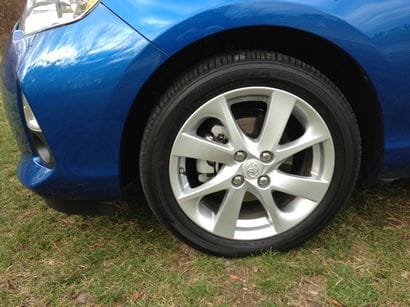
Also standard is automatic climate control, a 3.5-inch TFT display, AM/FM CD player, satellite and HD Radio with hands-free phone capability and Bluetooth music streaming.
The Prius c Two adds 60/40 split fold down rear seats, cargo cover and cruise control.
The Prius c Three adds display audio with navigation and Toyota's Entune smartphone interface as well as a Smart Key System for the front doors and liftgate, touch tracer display and the availability of an optional power moonroof and 15-inch alloy wheels.
The Prius c Four adds 15-inch alloy wheels with P175/65R15 83V tires, SofTex heated front seats, fog lamps and color-keyed heated power outside mirrors with turn signal indicators. The power moonroof and alloy wheel package is also an option on this trim level.
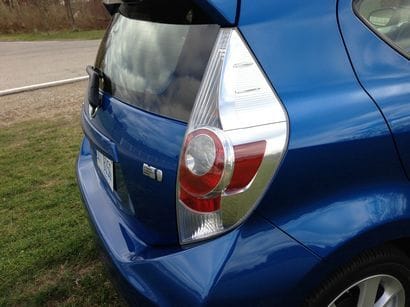
Pricing
Toyota new car prices, including a $795 delivery, processing and handling fee, begin at $19,745 for the Prius v Two. Our fully-optioned Blue Streak Metallic Prius v Four had a base price of $23,230. Adding the Alloy Wheel and Moonroof Package at $1,150 meant that the vehicle we tested checked in at precisely $25,140.
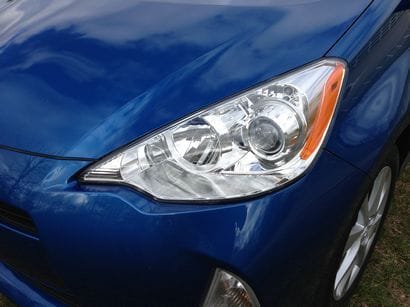
The Bottom Line
Unlike other members of the Prius family, there are times when the Prius c can be downright fun to drive. The fact that the majority of these scenarios play out in urban settings only serves to underscore why Toyota chose to equate the letter "c" in the models nomenclature with the word "city."
At the same time, even the entry level Prius c One is fully $4,400 than the least expensive Mazda2 automatic and the c isn't nearly as involving for drivers. Despite the fact that the Prius c posts much better city/ highway/combined EPA mileage figures – 53/46/50 mpg versus the Mazda2's 28/34/30 mpg, with gas prices hovering near the $3.70 per gallon mark it would take nearly six years for a Prius c owner to recover the cost differential even if it was a cash buy.

That figure is also based on driving 15,000 miles a year, a figure that very few urban drivers I know manage to hit.
However, it's my feeling that for most Prius buyers, the most important considerations are driving something with a smaller carbon footprint while telegraphing to others that this takes precedence over saving a few thousand dollars in overall ownership costs.
But whatever those reasons might be, potential buyers should know this: not only is the c the most affordable Prius model, it's also, by far, the most entertaining.















